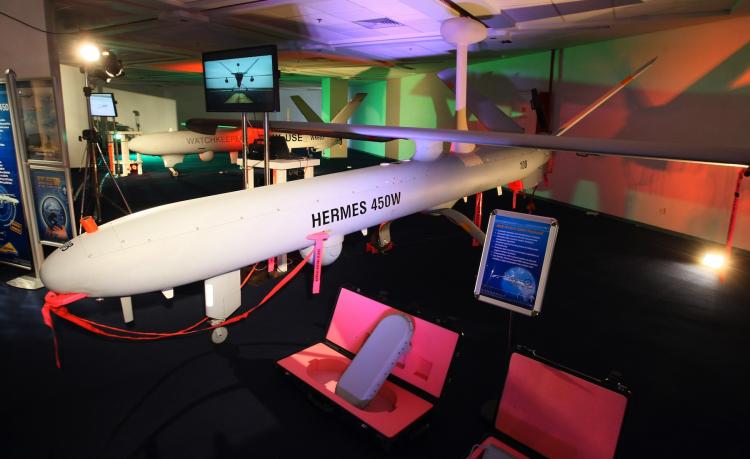Unmanned vehicles, often referred to as drones, are quickly becoming the mainstay of the battlefield—a weapon of choice due to low cost and keeping soldiers out of harm’s way. As warfare enters an age of armed robots, however, ethics and how far this should go are coming into play.
“The tech term ‘killer application’ takes on new meaning in this space,” said P.W. Singer, author of “Wired for War,” in a Feb. 2009 TED Talks video.
The war in Iraq began with just a handful of unmanned vehicles, yet that number has jumped into the thousands. It’s success has begun a booming industry of military unmanned vehicles—robots armed for combat, devoid of human feeling, and acting at the command young soldiers miles away in front of computers.
The face and experience of war is changing, and as Singer describes it, the technology is still in its “Model T” stage. What is currently on the field is just the beginning, and although the United States is the current leader in military robotics, other countries are quickly adopting it.
In 2009, there were 43 countries developing unmanned vehicles, according to Singer, and that number may only grow as the systems become even less expensive and more widely available.
“What that means is that things that used to only be talked about at science fiction conventions like Comic Con, have to be talked about in the halls of power—places like the Pentagon. The robot revolution is upon us,” he said.
Changing Battlefield
There is a tough debate over the ethics of unmanned vehicles, and the military is unlikely to abandon the technology any time soon.
Unmanned vehicles take soldiers out of harm’s way. While patrolling the skies, they are largely immune to potential ambushes, planted explosives, and other dangers ground troops would face. Since the vehicles are small they also use fewer resources, they have a broad range of view, and require only a single pilot who is safe behind a computer in a Nevada military base.
There are quite a few horror stories, however, of misguided strikes killing innocent people.
“Sourcing on civilian deaths is weak and the numbers are often exaggerated, but more than 600 civilians are likely to have died from the attacks. That number suggests that for every militant killed, 10 or so civilians also died,” states a report from The Brookings Institution.
Whether unmanned vehicles violate international law is being debated. “The specific weapons fired from armed drones may not be currently illegal. However, taken as a whole, the drone weapon system—both as it operates now and its future potential for autonomous killing—may well be uniquely dangerous and a candidate for banning,” states a report from U.K.-based organization The Fellowship of Reconciliation.
Read more: A Detached Approach to War
There is also a detached approach to war that the unmanned vehicles bring. Singer noted that pilots of unmanned systems are often more susceptible to post traumatic stress disorder—a factor he attributes to this.
“You’re going to war for 12 hours, shooting weapons at targets, directing kills at enemy combatants, then you get into your car and drive home and you’re sitting at your dinner table talking with your kids about their homework,” a Predator pilot told Singer.
Experts have compared the weapon systems to playing a video game. There is concern detachment from the battlefield blurs the lines between reality and the virtual world.
Killer Robots
The real concern with unmanned combat vehicles, however, is how far the technology will go. History has shown that where there is demand, there will be supply, and companies are already competing selling the vehicles internationally.
The Predator unmanned vehicles, manufactured by U.S.-based General Atomics, are being sold to the United States, Italy, and Turkey. The Harpy, made by Israel Aerospace Industries, is being sold to China, South Korea, India, and others. Similar vehicles are being sold to other countries.
Still, the next stage presents a more frightening picture. Currently in the works are autonomous systems—killer robots devoid of human pilots.
DARPA, the U.S. military’s research branch, began developing autonomous air, ground, and sea vehicles dubbed “Killer Robots” in the early 1980s.
“In 1985, various DARPA efforts (including Killer Robots) became part of the new Tactical Technology Office (TTO) Smart Weapons program (SWP) to develop a modular family of smart, autonomous weapons. Advances in computer technology and software (such as Automatic Target Recognition) were believed to finally have made a true autonomous loitering weapon possible,” states a DARPA report on autonomous navigation, titled “A driving force.”
Military systems are pushing the bar about as far as it can imaginably go—with everything from remote-controlled cyborg rats, to robots that can fuel themselves by consuming biological materials (DARPA asserts the chainsaw-wielding Energetically Autonomous Tactical Robots are strictly vegetarian).
With one program, the Self-Explanation Learning Framework (SELF), DARPA plans to build “cognitive” robots that can build themselves. “DARPA seeks to construct systems that can participate in their own construction,” states a 2009 DARPA report.
Among roboticists, there are mixed views around the actual threat posed by autonomous military robots.
With more than 11,000 robots in the U.S. military in 2009, “If current trends continue, it is foreseeable that once military robots become more common on the battlefield, they will gradually also become more and more capable and more autonomous,” Armin Krishnan in his book, ‘Killer Robots, Legality and Ethicality of Autonomous Weapons.’”
He adds that there is concern “about future conventional weapons that could turn war into little more than massacre.”
Singer stated that the world may very well be at a juncture similar to the advent of the atomic bomb, and questioned “Are we going to face the reality of that in the 21st century war.”






